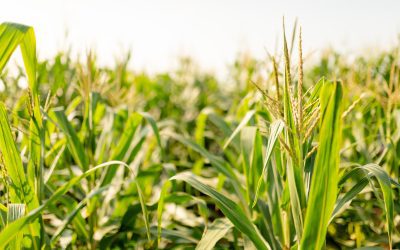Projected 2020-21 marketing year ending stocks of both U.S. corn and soybeans are down sharply from recent years thanks to a variety of factors, including recovery from COVID-19 impacts, more exports – particularly to China – and increased ethanol and feed use.
“I can’t remember a time when there were as many variables in play as there are today,” mused U.S. Soybean Export Council CEO Jim Sutter. “No wonder there’s some volatility and uncertainty in the marketplace.”
The USDA’s World Agricultural Supply and Demand Estimates (WASDE) report from April 9 reflected global corn ending stocks are estimated to be sharply lower than in recent years. at the end of this marketing year on August 31. The global estimate is 283.8 million metric tons (MMT), or about 11.2 billion, about 12 percent. This is even down from WASDE’s March estimate of 1.5 billion bushels.
The global estimate is under last year’s 303 MMT and 321.1 MMT for 2018-19; in those years, the U.S. housed more than 16 percent of corn ending stocks. U.S. corn’s expected stocks-to-use ratio in this marketing year is just 9.2 percent, a dip from 13.7 in 2019-20.
In its March 1 Grain Stocks report, the USDA reported the U.S. was holding 7.7 billion bushels of corn, down 3 percent from one year earlier. Indiana, however, was up from March 2020 – by 5 percent to 515.5 million.
At the end of March, USDA published its annual Prospective Plantings for the U.S. It estimates growers will seed 91.1 million acres of corn, up slightly more than last year’s 90.8 million. Indiana is projected to plant 5.2 million, down from 5.4 million in 2020.
Soybean ending stocks are estimated to be extremely tight in the United States – less than 4 percent of the 86.9 MMT worldwide stock, at just 120 million bushels. Last year, the U.S. had 14.9 percent of the world’s 96.4 MMT ending stocks, and in 2018-19, it was 22 percent of 114.5 MMT.
The stocks-to-use ratio for U.S. soybeans is projected to be 2.6 percent – in 2018-19 that figure was closer to 23 percent, and last year it was 13.3.
Across the country, the USDA estimated March 1 U.S. stock at 1.56 billion bushels, down a whopping 31 percent from March 2020. In Indiana, soybeans were down 18 percent from the previous spring, to 142.5 million bushels.
USDA expects more soybean acres
Prospective Plantings of U.S. soybeans are estimated at 87.6 million acres, up 5 percent from 83.1 million last year and 76.1 million in 2019 – however, it is lower than the USDA Agricultural Outlook Forum projection of 90 million acres in February.
Indiana is forecast to plant 5.8 million acres to soybeans, compared to 5.7 million in 2020 and 5.4 million two years ago. Illinois and Iowa are still the undisputed national champs, but North Dakota is expected to step up with 7 million acres – 22 percent over last year.
Ed Ebert, senior director of Grain Production and Utilization for Indiana Soybean Alliance and Indiana Corn Marketing Council, noted the WASDE report in June 2020 had forecast 2020-21 corn ending stocks of 3.3 billion bushels – well off the 1.35 billion projected on April 9.
“I can’t remember a reduction of 2.2 billion bushels of corn ending stocks between a June WASDE estimate and the following April WASDE,” he said. And the June 2020 WASDE projected 2020-21 soybean ending stocks at 395 million bushels – more than triple April’s 120 million forecast.
This came on top of trade expectations being undercut by lower Prospective Planting numbers on March 31. Ebert said the market was estimating an announcement of 93.2 million acres of corn and 90 million in soybeans to be planted – and was shocked by 91.1 million and 87.6 million, respectively.
That same day, he noted corn and soybean prices both rose limit-up on CBOT. Soybeans backed off slightly in the two weeks following, but he said, “When you look at December corn … it is fully 12 to 15 cents higher” than the mid- March price. This product closed April 12 at $4.96 per bushel, not budging from the previous Friday.
November soybeans closed April 12 at $12.50, down 13 cents from the previous Friday’s post-WASDE price but still up over the mid-March price by less than a dime.
More crop in the ground
Ebert said there is the sense in the market that U.S. farmers will put more crop in the ground than Prospective Plantings reflected, since prices are up. He hears many growers are considering the option of planting soybeans earlier than normal, alongside corn.
Because processing plants will have high demand for old crop beans before fall harvest, he explained if farmers can grow and harvest soybeans by August, they may be able to take advantage of marketing those as “old-crop” for premium pricing – in addition to actual old crop now in the bin.
It is possible corn prices could have gone higher on the April 9 WASDE. On April 8, Chicago analyst Virginia McGathey of McGathey Commodities said traders were expecting Brazilian corn production to fall from 1.09 to 1.05 MMT – but it didn’t.
“It is hard to derail this freight train that is Brazil right now,” said Kevin McNew, chief economist for Farmers Business Network, though he explained the South American country is raising soybean output faster than corn.
Ramped-up Chinese feed demand is a major factor for both commodities in the past year, as the country rebuilds its hog herd after African swine fever losses. He noted for soybeans, “We’re seeing a shift around protein (there).” He added, “It’s always been pork that’s the main protein … but now they’re branching into poultry, branching into more beef.”
As for corn exports to China, McNew speculated, “It’s a big new demand source that I think is probably permanent, and it does add another interesting dynamic to pricing, going forward.”
WASDE estimated the U.S. will export almost 2.68 billion bushels of corn worldwide this marketing year, compared to 1.78 billion last year and 2.07 billion in 2018-19. U.S. soybeans will see anticipated foreign sales of 2.28 billion bushels, compared to 1.68 billion last year and 1.75 billion in 2018-19.




